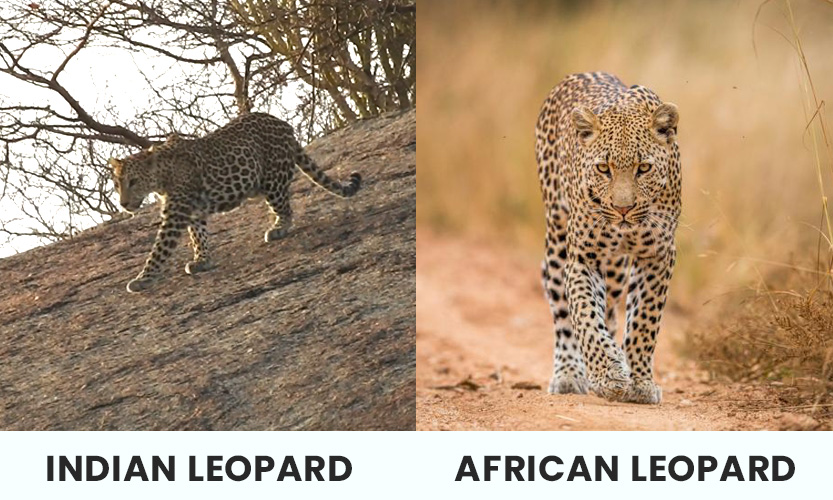The Indian leopard is a subspecies of leopard that is found in many areas of the Indian subcontinent. Its scientific name is Panthera pardus fusca and it is listed as ‘vulnerable’ on the IUCN Red List.
However, in recent years, the population of this species has increased rapidly in many areas due to the joint efforts of the government and activists.
As per the national census of leopards that happened in 2020, the overall population was estimated at around 12,500 to 13,500 in India and hopefully, this number has increased today. Leopards are known for their stealthy behavior, agility, and adaptability, and these attributes are seen in the Indian variant as well.
Throughout the country, leopards are scattered in many areas and they are often seen infiltrating into the human settlements. The main reason behind that is the fact that most of the reserves focus on tigers and since they are larger in size and more powerful too.
They force the leopards to take shelter in the outskirts of the jungle that are near human settlements. Lately, we have seen a large number of viral videos in which leopards have been in residential areas.
In the past, we have seen people beating the beasts to death but such scenarios are now reducing in numbers and we are taking a humane approach towards them.
Let us now dig into the Physical Attributes of the Indian leopard:
Indian Leopard Weight
Like many other species, Indian leopards are also sexually dimorphic and the major difference between the males and females appears in their weight.
The weight of males ranges between 50kg to 77kg (110lb to 170lb) and for females, it is 29kg to 34kg (64lb to 75lb). So far, the largest leopard in size who was found in the Dhadol area of Himachal Pradesh in 2016, was weighed 71 kg (157lb). He was also a man-eater and shot because of it.
Indian Leopard Habitat
As mentioned above, leopards are highly adaptable and because of this, they are found in diverse tracts across the globe. The Indian leopards are found in the Himalayas, mangroves, and even in the arid regions of Rajasthan.
They are agile and smaller in size and usually take shelter on the branches of the high trees where they can secure themselves and their kill from scavengers. In Jawai (Rajasthan), they have taken shelter in the granite hills and have formed a harmonious bond with the humans as well.
Indian Leopard Facts
Leopards are very mysterious in terms of behavior which has been seen in a few wildlife footages. In particular footage of National Geographic, a leopard kills a baboon that had its infant clung to its chest, the former feeds on the later but does not harm the young one.
On the contrary, the leopard cuddles the infant and gives us some jaw-dropping moments. In another one, a leopard gets hold of a young deer and does not kill it, to the utter amazement of the spectators it starts fondling the baby deer.
Indian Leopard Population
As mentioned above, the population of Indian leopard according to the census done in 2020 was around 12,500 to 13,500 and we expect this number to be higher right now.
Indian Leopard Footprint
The footprints of Indian leopards are amazing to watch, they are round in shape with tiny five spots around them. Since the size of the legs of leopards is smaller than that of tigers and lions, one can easily recognize the footprints of leopards as long as they are walking on earthly turf. In the alpine regions, you cannot track leopards with footprints and have to depend on binoculars or tracking devices.
Indian Leopard Size
When it comes to size, sexual dimorphism emerges again and we can see the difference between males and females. The body-size of males grow between 4ft 2in (127 cm) to 4ft 8in (142 cm) with the tail of 3ft (91 cm). The body-size of females grow between 3ft 5in (104 cm) to 3ft 10in (117 cm) with the tail of 2ft 6in (76 cm).
Indian Leopard Speed
The leopards are known for their agility and if they run, they can reach the speed of 58km/h. Moreover, they can leap vertically to 3 meters and horizontally to 6 meters.
difference between Indian Leopard vs. African Leopard
Let us now differentiate between Indian leopards and African leopards. There are other species of leopards as well, but in the article, we will highlight the major differences between these two. We will understand them better with details put down in a table.

| Indian Leopard | African Leopard |
| Its scientific name is Panthera pardus fusca | Its scientific name is Panthera pardus pardus |
| It is scattered in various regions of Indian subcontinent. | It is found in sub-Saharan Africa and North Africa as well. |
| The coat is spotted and rosettes are prominent on hindquarters, back, and flanks | It has great variation in the coat color that varies as per the location and habitat |
| Males weigh 50kg to 77kg (110lb to 170lb) | Males weigh 60 kg to 91 kg (130lb to 201lb) |
| Females weigh 29kg to 34kg (64lb to 75lb) | Females weigh 35 kg to 40 kg (77lb to 88lb) |
| Habitat ranges from mangroves of Bengal to the alpine regions of the Himalayas and arid regions of Rajasthan. | Habitat ranges from grasslands and mountainous forests of savannahs to the rainforests and arid desert of sub-Saharan Africa. |
| Diet includes peafowl, wild boar, axis deer, sambar deer, nilgai, common langur, and Indian hare | Diet includes large ungulates, rodents, birds, anthropods, hares, hyraxes, and antelopes |
| The skull size is 28cm (11.2in) in basal length, 20cm (7.9in) in breadth, weighs 1000g (2lb to 4oz) | The skull size is 28.6cm (11.25in) in basal length, 18.10cm (7.125in) in breadth, weighs 790g (1lb to 12oz) |
Both the Indian and African leopards are known for their fine hunting skills with which they can kill prey that is larger and heavier in size. And when leopards kill an animal, they don’t just keep it in-ground, they have to secure it from the packs of wild dogs and hyenas as well. For that, they clamber up the high branch of a tree while holding the prey in their mouth.
This feat has been achieved only by the species of leopard and we can certainly say that it is way more skillful than their heavier counterparts. As soon as you lay your eyes on any of these species, you get mesmerized to the hilt. From their color to physical attributes, everything amazes the spectators.
That is the reason thousands of tourists including zoologists, environmentalists, and photographers are drawn towards this species. The leopards are opportunistic killers, stealth is their primary weapon and the success ratio of their hunting attempts is very impressive if you compare it with that of other big cats. Both of these species are very valuable to us and the conservation efforts for the increase of their numbers are also giving positive results now.
They have been an easy target for poachers as the leopards are found mostly on the borderline areas of the nationals parks and sanctuaries. However, we can see that the efforts are giving great results and we can see this magnificent animal in a greater number now.
5 Best Places to See Leopard in India
In India, there are many best places to see leopards in india and we will tell you briefly about them today. As mentioned above, they can be seen in diverse lands, and therefore, it is important that we highlight the places where their sighting is easy. Here are the best places to spot leopards in India:-
1. jawai bandh leopard conservation reserve ( Rajasthan )
You have read this name before in this article and it was mentioned because of providing a different sort of habitat to the leopards. In this small region, you get to see leopards roaming about the granite hills and living in caves of primordial times. This is a place where you see plenty of beauty and an exceptional bonding between the leopards and humans.
That’s true, Jawai has been home to leopards and the nature-loving tribe of Rabari as well. These people even regard the leopards as the guards of their deity and don’t complain when the big cats kill their livestock occasionally.
Book Jawai Bandh Leopard Safari Online at : +919784559999
In Jawai, the experience of leopard sighting is entirely different, it is much more exploratory as you get to drive through the bumpy rocks. Furthermore, you get to see various species of migratory birds along with crocodiles, and many other species.
You can also take sneak-peek into the lifestyle of Rabari people who are living with the wilderness around them. They are people who understand wildlife and nature more than anyone. By seeing these people, you can also get inspired to love the bounties given to us by mother earth.
2. Jhalana Leopard Safari (Rajasthan)
Another place where leopards are apex predators and can be easily spotted as well. The locals around this sanctuary get to see the beasts often on the road in the night. However, there hasn’t been a single human-leopard conflict reported and people feel perfectly safe. At this reserve, you get to see the dense forests of Jhalana that provide a perfect shelter to several species.
The other species that you can see here are macaque, sloth bear, chinkara, sambar, nilgai, striped hyena, jackal, Indian wolf, jungle cat, etc. Along with mammals, you can also see a great number of birds throughout the year in any season.
After coming to this place, you get an idea of how diverse the wildlife in Rajasthan is. A tour of this place can open your mind and show you different colors of flora and fauna of this country.
You can roam about in these jungles for hours and never get tired. You can also stay in a nearby resort and get to see many types of birds, antelopes, and deer very easily. If you have come to Jaipur, it is very easy to reach Jhalana sanctuary. It is not located on the outskirts and reaching this place takes just a drive of a few minutes.
Therefore, doing a safari in Jhalana is a must for all the thrill-seekers who come to Jaipur.
3. Kumbhalgarh Wildlife Sanctuary (Rajasthan)
Here’s another place in Rajasthan where you can leopards along with plenty of other species and a huge fortress as well. With the overall area of 610.528 km2 (236 sq mi), this sanctuary is a part of Aravalli Range and Kathiawar-Gir dry deciduous forests ecoregion both. From the fortress, you can see some mesmerizing vistas of this area and capture them in your camera forever.
The fauna includes jungle cats, Indian hare, chinkara, striped hyena, Golden jackal, sambar deer, chausingha, sloth bear, etc. You can also see a diverse birddom here along with many species of insects and reptiles.
Coming to this sanctuary and seeing the wildlife here is an amazing experience that you cannot miss if you are a true wildlife lover. At this place, you get to see some amazing species including red spurfowl, golden oriole, white-breasted kingfisher, parakeet, grey junglefowl, grey pigeon, bulbul, dove, etc.
Once you come here, you get to feel the richness of the wildlife which piques your interest and prods you to keep exploring. Kumbhalgarh sanctuary has been chosen as one of the places Asiatic Lion Reintroduction Project and we can soon expect to see this splendid being here.
4. Satpura National Park (Madhya Pradesh)
It is one of the tiger reserves in Madhya Pradesh with a total area of 524 km2 (202 sq mi). It derives its name from the Satpura range of hills is located near the wildlife sanctuaries of Pachmarhi and Bori. Like many other forest reserves, this one also provides shelter to a large number of birds along with mammals, reptiles, trees, and plants. If you talk about the geographical attributes, you can see ravines, sandstone peaks, dense forests, narrow gorges here.
There are multiple high-altitude points in this park, the highest of them is the Dhoopgarh peak that is 1,350 meters (4,430 ft) tall.
When you talk about the animal kingdom, you get to see tigers, leopards, sambar, chital, Indian muntjac, nilgai, four-horned antelope, antelope, wild boar, blackbuck, porcupine, fox, Indian giant squirrel, mouse deer, flying squirrel, etc.
The richness of flora is also noticeable in this reserve as you get to see sal, teak, tendu, Phyllanthus, Emblica, mahua, bel, bamboo along with many other medicinal plants.
Satpura is notably very close to Bhopal and this makes it a go-to destination for ecotourism. Thousands of tourists come to this national park every year to get amazed by its beauty and diversity.
5. Bandipur National Park (Karnataka)
Situated in the state of Karnataka, this national park has the second-highest population of tiger in India. It encompasses a total area of 874 square kilometers (337 sq mi) and came under the Project Tiger in the year 1974. Bandipur becomes a shelter for a large number of endangered species and it is located at the junction of the Deccan Plateau and the Western Ghats.
If you talk about fauna, you get to see chital, gray langurs, Indian elephants, gaurs, sloth bears, muggers, Indian rock pythons, four-horned antelopes, jackals, dholes, tigers, leopards, etc.
Bandipur National Park amazes you with its biodiversity and the overall aspects of wildlife. Once you come to this place, you get bemused with its sheer beauty and remember it for good. There are many types of trees and plants that incite you to come closer to nature.
You can experience your best wildlife moments in this reserve and bring your loved ones on the safari s well. The vastness of this park lets you enjoy many things and gives you great insights into the wilderness of this country. At this wildlife reserve, you get to spend the most thrilling moments with a safari full of adventure.
Final Words
Out of all those places, Jawai is one where you get to see a different habitat for leopards, it is a place that allows you to explore an unseen side of Indian wildlife. At this place, you can have an unparalleled experience of spotting leopards while going through the rocky terrain. This makes the safari ride even more adventurous and you can relish every moment of it for a very long time.
Here, you allow yourself to come closer to nature without any restrictions and dig deeper into it. And if you choose the right partner for safari and stay, your tour to Jawai could become the most precious memory of your life.
Thour Nature Resort is the name that you can trust for having a safe and adventurous safari along with a luxurious stay. We are a resort property that operates with the sole purpose of amazing our guests with the beauty of this place.
Our experienced drivers take you to all those spots where you can easily spot leopards along with the birds, crocodiles, and other animals without wasting time. Due to the ongoing situation, we are adhering to all the guidelines to ensure 100% safety of our guests.
The rooms, jeeps, and the entire premises are sanitized from time to time and you can easily maintain social distancing from other guests as the tents are placed afar from each other.
Do you wan to Book Jawai Leopard Safari ? Call/Whatsapp : 9784559999 | Email Us at : [email protected]








